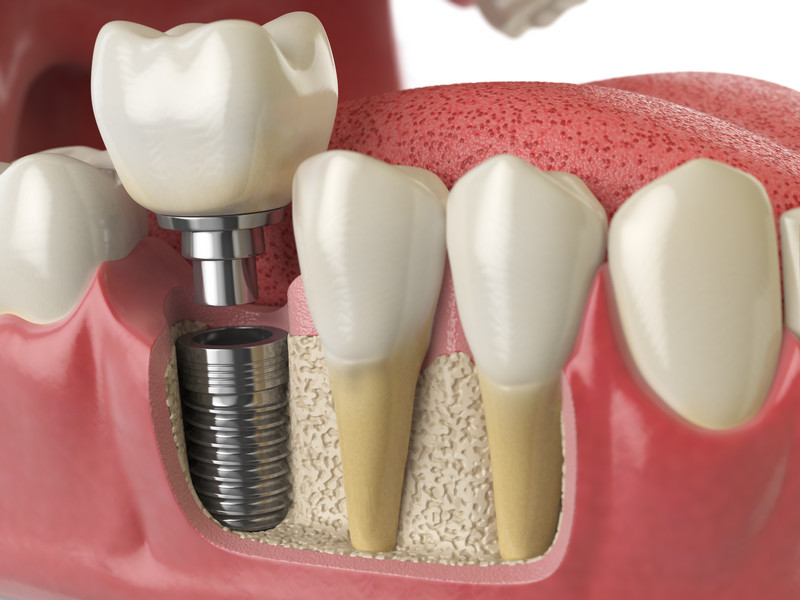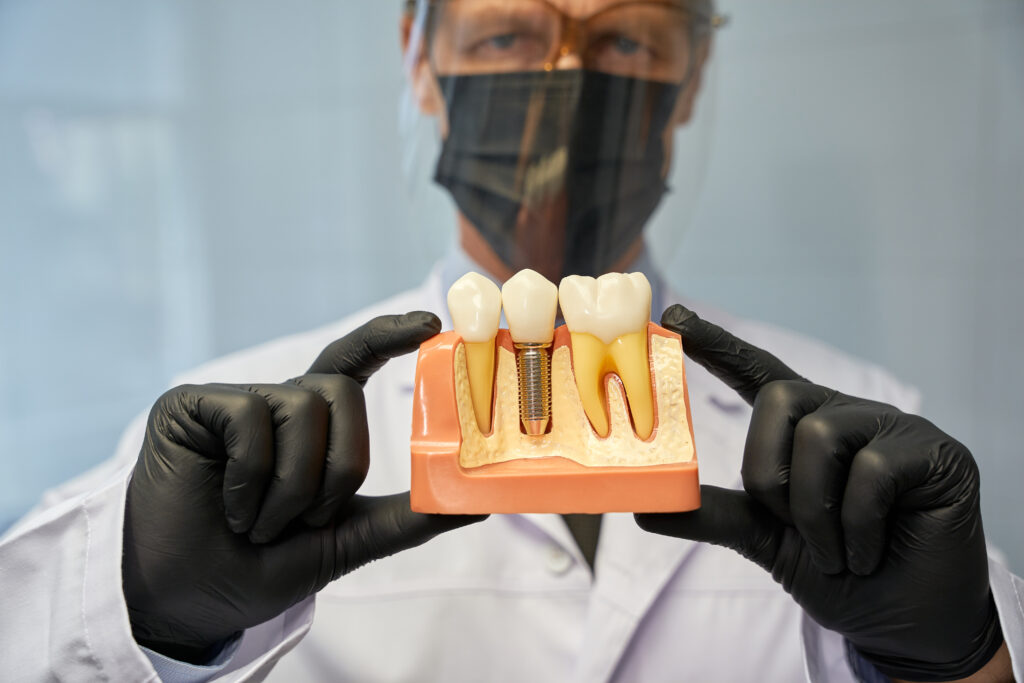
Have you lost a tooth or two to decay, injury, or gum disease? Are you feeling a little self-conscious about your smile lately? Dental implants can be a game-changer, offering a long-lasting and reliable alternative to natural teeth. Dental implants have fast become a go-to option for people seeking to rejuvenate their smiles.
Today, we’ll walk you through the dental implants procedure, giving you a comprehensive step-by-step guide to help you better understand the process.
What Is a Dental Implant?
A dental implant is a remarkable dental solution that provides a long-lasting and great replacement for missing teeth. It involves the surgical placement of a metal stud or post, typically made of titanium, into the jawbone. This metal stud is a sturdy anchor for a crown or false denture. The dental implant provides stability and support for the replacement tooth or teeth by serving as an artificial tooth root.
The use of titanium in dental implants is crucial due to its unique properties. Titanium implants are biocompatible, meaning they are well-tolerated by the body and do not cause adverse reactions. Additionally, titanium can fuse with the bone during the healing process, a phenomenon known as osseointegration. This integration creates a strong bond between the implant and the jawbone, ensuring a solid foundation for the replacement tooth.
What Are the Parts of a Dental Implant?
1. Implant (Titanium Post)
The implant is the foundation of the dental implant system. It is surgically placed into the jawbone, mimicking the role of a natural tooth root. The titanium material of the implant promotes osseointegration, allowing it to fuse with the surrounding bone and create a stable base for the replacement tooth.
2. Abutment (Connector)
The abutment is attached to the implant once the healing process is complete. This connector is carefully selected and customized to ensure a precise fit. The abutment protrudes above the gumline and provides access for attaching the crown or denture. It’s crucial to connect the implant to the visible part of the dental implant restoration.
3. Crown (Artificial Tooth)
The crown is the visible part of the dental implant restoration and is the replacement tooth. It is custom-made to match the color, shape, and size of your existing teeth, ensuring a seamless and natural-looking appearance. The tooth crown is securely attached to the abutment, completing the dental implant restoration and providing a functional and aesthetically pleasing result.
When Should You Consider Dental Implant Surgery?
You Have Missing Teeth
Dental implant surgery is a highly practical method for replacing individual or multiple missing teeth. Regardless of whether you have lost a single tooth due to injury, tooth decay, or other reasons, this surgery can provide you with dental implants that can restore your smile and oral function.
You Are Suffering From Jaw Bone Loss
Dental implants are particularly valuable when there has been significant bone loss, such as due to advanced periodontal disease. The implants can be placed directly into the jawbone to provide stability and support for replacement teeth, even in cases where traditional dentures may not be suitable.
To Support Removable Dentures
Dental implants can also support removable dentures, providing a more secure and comfortable fit. Implant-supported dentures offer greater stability, preventing slippage and improving overall oral function.
Improved Functionality
Dental implants restore the ability to chew properly, allowing you to enjoy a wider range of foods and improving oral function. They provide stability and strength, similar to natural teeth.
Enhanced Aesthetics
In addition to functionality, dental implants offer aesthetic benefits. The replacement crowns or false dentures attached to the implants are custom-made to match the color, shape, and size of your existing teeth. This ensures a seamless, natural-looking, perfect smile, enhancing your appearance and confidence.
The Dental Implant Procedure: Step-by-Step
Step 1: Preparatory Precautions
Before dental implant surgery, your dentist will take the necessary precautions and conduct a comprehensive examination. This includes assessing your oral health, reviewing your medical history, and taking X-rays and scans to evaluate the condition of your jawbone and surrounding tissues. These precautions ensure that you are an ideal candidate for the procedure and help the dentist develop a personalized treatment plan.
Step 2: Bone Grafting (If Necessary)
In cases where the jawbone lacks sufficient density or has experienced significant bone loss, a bone graft may be necessary. During this dental procedure, bone graft materials, such as synthetic bone or your bone tissue, are placed in the deficient areas of the jawbone, including the soft tissue. This promotes both bone growth and the regeneration of soft tissue, providing a solid foundation for the dental implant.
Step 3: Dental Implant Placement
The dental implant placement surgery can begin once necessary preparations and bone grafting are completed. An oral surgeon typically performs this surgical procedure under local anesthesia, ensuring your comfort. During this dental implants process, the oral surgeon will carefully make an incision in the gum tissue to expose the jawbone. Then, a small hole is drilled into the bone, and the implant is inserted into the precise location. The gum tissue is sutured back, leaving the implant securely in place.
Step 4: Healing Period (Osseointegration)
After implant placement, a critical process called osseointegration occurs. This is when the implant fuses with the surrounding jawbone over time, creating a strong and stable foundation for the replacement tooth. During the healing period, which can span several weeks to a few months, it is crucial to follow proper dental care practices, avoid smoking, and maintain a healthy diet to promote successful osseointegration.
Step 5: Abutment Placement
Once osseointegration is complete, the next step is the placement of the abutment. The dentist will reopen the gum tissue to expose the implant, and an abutment is attached. The abutment serves as a connector between the implant and the replacement tooth, providing stability and support.
Step 6: Dental Crown Placement
After the abutment, your dentist will take impressions of your teeth and gums to create a custom-made crown. The crown is designed to match the color, shape, and size of your natural teeth, ensuring a seamless and natural-looking result. Once the crown is ready, it is securely attached to the abutment, completing the dental implant restoration.
How Do You Maintain and Care for Dental Implants Post-Surgery?
- Dental Hygiene. Maintain good oral hygiene practices, including brushing twice daily, flossing daily, and rinsing with an antimicrobial mouthwash. This helps prevent plaque buildup and keeps your gums and implant clean and healthy.
- Regular Dental Checkups. Schedule regular checkups and professional cleanings to monitor the health of your dental implants. Your dentist will also assess the condition of your gums and perform any necessary adjustments or repairs.
- Avoid Damaging Habits. Avoid smoking, chewing on hard objects, and grinding your teeth, as they can damage your implants and compromise their longevity.
- Healthy Lifestyle. Maintain healthy lifestyle habits like eating a balanced diet, limiting sugary foods and beverages, and exercising regularly. These habits significantly minimize complications, reduce the healing time, and maximize the long-term success of your dental implants.
Schedule Your Dental Implant Treatment at My Absolute Smile Today!
The breakdown of the dental implants step-by-step procedure mentioned in this guide shows that this procedure is worth taking. Dental implants offer an excellent path for those yearning to restore their vibrant smiles. Remember, each dental journey is unique, and the dental implant’s step-by-step procedure could vary slightly based on individual circumstances.
For professional dental consultations and advice on whether dental implants are the right fit for you, don’t hesitate to schedule an appointment at My Absolute Smile today. We are committed to helping you understand each step of the implant procedure and guiding you to a more confident smile.
Remember, a radiant smile is a beautiful one. At My Absolute Smile, we are not just about oral health but about creating smiles that boost your confidence and overall happiness. Because with us, it’s more than a procedure. It’s a transformative journey to a smile that you’ll love.







